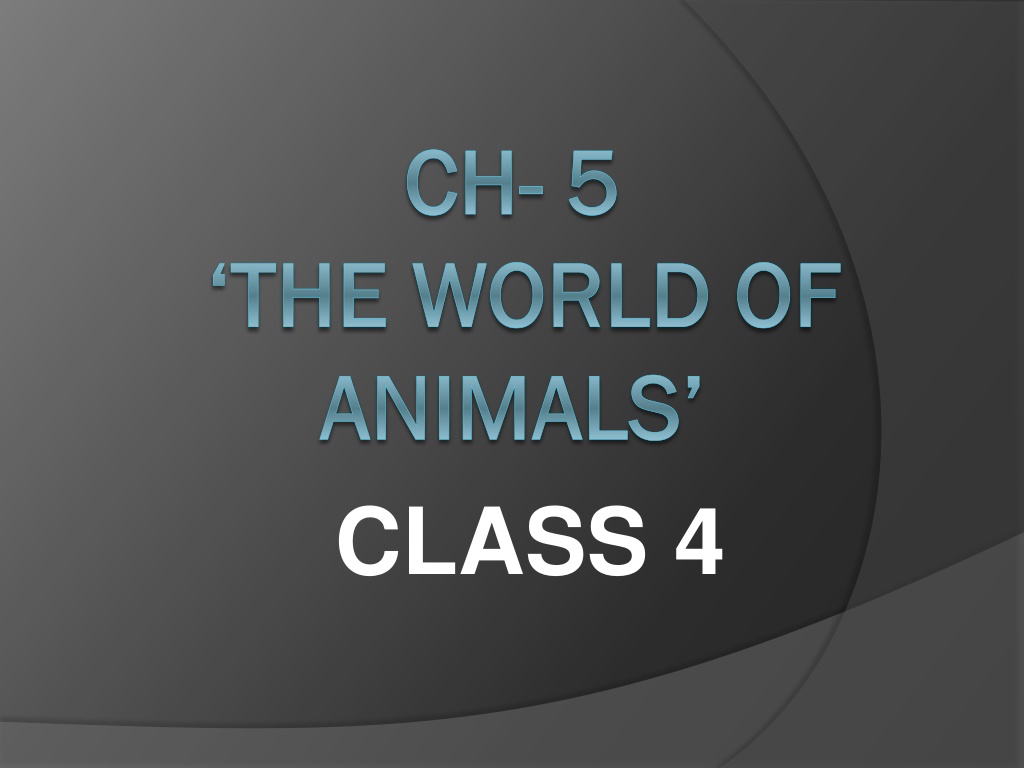
Explore the Fascinating World of Animals and Habitats
Dive into the intriguing world of animals and their habitats with information on diverse species and their unique adaptations. Learn about habitats, body features, eating habits, and more. Discover how animals survive and thrive in various environments through engaging examples and explanations.
Download Presentation

Please find below an Image/Link to download the presentation.
The content on the website is provided AS IS for your information and personal use only. It may not be sold, licensed, or shared on other websites without obtaining consent from the author. If you encounter any issues during the download, it is possible that the publisher has removed the file from their server.
You are allowed to download the files provided on this website for personal or commercial use, subject to the condition that they are used lawfully. All files are the property of their respective owners.
The content on the website is provided AS IS for your information and personal use only. It may not be sold, licensed, or shared on other websites without obtaining consent from the author.
E N D
Presentation Transcript
CH CH- - 5 5 THE WORLD OF THE WORLD OF ANIMALS ANIMALS CLASS 4
HABITATS HABITATS ANSWER THE FOLLOWING. Q1. What is habitat? Ans. A habitat is a place where animals live and grow naturally. Q2. How do aquatic animals breathe? Ans. Aquatic animals breathe through gills. Q3. What is hibernation? Ans. In cold regions, some animals such as polar bear go into deep sleep to protect themselves from the cold. This long winter sleep is called hibernation.
Q4.How are camels adopted to live in the deserts? Ans. Camels have thick skin to protect themselves from the extreme heat and to avoid water loss. They also store water in their stomachs and fats in their humps. Q5. Which type of bodies do aquatic animals have? Ans. Aquatic animals have streamlined bodies which help them swim easily.
GIVE ONE EXAMPLE OF EACH GIVE ONE EXAMPLE OF EACH- - Lives inside burrows and holes. Rabbits Stores fat in its hump. Camel Have thick skin or a layer of fur on its body. Polar bear An animals with webbed feet. Salamander An animals breathe through gills. Shark
BODY FEATURES BODY FEATURES Complete the table. ANIMALS BODY FEATURES Snake Scales Snail Hard shell Bears Fur Lizards Scale Fish Scale zebra Strong legs
GIVE REASONS GIVE REASONS- - 1. A zebra has strong legs. Ans. Zebra has strong legs to run fast, so they can run away from predators quickly. 2. Snakes shed their skin regularly. Ans. Snakes shed their skin regularly for- a. Further growth b. Protect from parasites. 3. Tortoise has hard shell. Ans. When tortoise senses danger, it puts its head and feet inside its shell to protect itself.
4. Chameleons blend themselves with their surroundings. Ans. Chameleons blend themselves with their surroundings in such a way that they cannot be spotted by easily by the predators.
EATING HABITS Q. Write the difference between Carnivores and Omnivores a) Carnivores Omnivores 1) Flesh eating animals are called carnivores. 1) Both flesh and plants eating animals are called omnivores. 2 ) They use their sharp front teeth and strong grinding teeth to eat food. eg crows, bear, cockroach etc. 2 ) They have sharp tearing teeth and claws, which help them in eating flesh. eg lion, wolf, tiger etc.
B) Vertebrate and Invertebrate Invertebrate Vertebrate 1 ) Vertebrate are animals that have a backbone. 1 ) Invertebrate are animals that don t have a backbone. 2 ) They include birds, fish, amphibians, reptiles etc. 2 ) They either have a soft body like worms and jelly fish or a hard outer covering body like crabs, snails etc.
Complete The Table Animals Cow Hyena Elephant Crow Leech Wolf Mosquito Cockroach Eating Habits Herbivores Carnivores Herbivores Omnivores Parasites Carnivores Parasites Omnivores
Q. Define the terms Q. Define the terms 1. Predators Predators are animals who live by killing and eating other animals. 2. Streamlined body A streamlined body is a shape designed to help the animals flow smoothly in water and fly smoothly in air. 3. Camouflage The colour and shape of some animals in such that they merge or mix with their surroundings. This is called camouflage. Camouflage makes it difficult for predator to spot the animals.
4. Parasites Parasites are small animals which live on or inside the body of other animals. These animals have suckers or sucking tubes to suck the food from other animals. eg Mosquito, Leech, Bed Bug, Worms etc.
